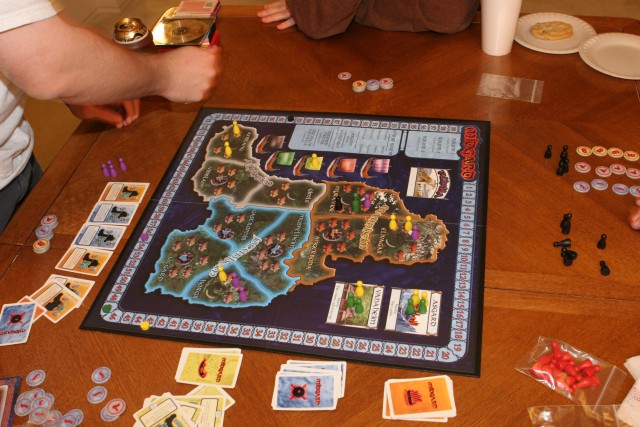
Imperial was the first game that we played. And, this time, we played with a no investor card. This option makes the following changes: only landing on the investor space on the roundel causes a payout; when you skip past the investor space, nothing happens; at the end of a nation’s turn, everyone gets a chance to buy/upgrade a share; if someone does not control a country, then they can invest in any country.
I like this variant much better. You do not spend a lot of the time waiting for your chance to invest. Your money is invested much quicker than before. You have more chances to invest in a country before it pays out its bonds or take control over in a country that might be able to tax.
Surprisingly, I was able to control both Austria and Italy with the 3 level share throughout the game. No one bothered to take control away from me. Perhaps because I did not transform them into powerhouses like I have in the past.
Early on in the game, I could see that Adam was trying an interesting strategy. After gaining control of the three sea areas surrounding England, he concentrated on building factories, taxing, and investing. This is not something that I have seen others do before in this game. And, now that I think about it, I wonder why more people don’t do that. Factories are worth the same as two neutral countries. And they are much easier to hold. No one ever invades other people’s countries in this game. Plus, England is more isolated than other countries in this game. As long as she controls the seas around her, England is safe.
So, I made sure to start investing heavily in England. It also helped that John would upgrade his England shares and I was able to buy them before Adam could. Adam would pay out his England shares and I would pay out my Austria/Italy shares. So I was rolling in money. Which was nice.
But there came a point where I had a dilemma. England was close to ending the game with another taxation. This would get its shares into the x5 multiplier. I had enough money to upgrade my share and purchase the 8 level share. But I would not have enough money to get to the taxation space on the roundel. I was 1 dollar short! (How many times in this game have I been 1 dollar short from buying something or doing something?). Of course, France would have a turn before England and she could attack enough areas to stop England from getting to the 25 spot. Eventually, I just decided that more shares would be a good thing.
What is sad is that, at this point, I was looking to raid the treasuries of Austria and/or Italy. But their coffers were dry. Sigh. That does bring to mind a future strategy: use another nation as a blocker nation. Attack countries that threaten your primary nation. Or, use it for a source of money when you need it.
In the end, I was able to end the game with England. And win it by 5 points. But it was close! I was able to get Austria and Italy’s multipliers into the x3 category.

Next up, John brought yet another new game for us to play. It is an area majority game that uses card drafting to deal cards out. There are three large areas. Each area is sub-divided into three or four sections. Each section can hold from three to six people. There are three scoring rounds where you score points for the number of sections that you control in an area (3, 7, 12, 20), 5 points for majority in Asgard. You also get one corresponding token per person on the board. At the end of the game, each set of tokens (one for each area) count as five points.
I was not pleased with the card drafting part of it. If you are dealt some good cards, you only get one and pass the rest away. And if you are passed cards that you don’t want, then oh well. You are screwed. I would rather pick one from a number of face up cards and have that continue around the table. Also, the map is rather small and you have a limited number of actions. So, if you choose a strategy, then there is no guarantee that you will be let alone to implement it. Spots are fought after often. And this has the effect of nullifying your move.
In our game, John leaped up into the lead. He was able to score an area twice. And he scored a lot for going into the doomed areas. Something that the rest of us were avoiding. Because, while you score points for people placed into those areas. You remove those people and put them back into your boat. We had thought that it was better to have them stick around and score for later rounds. But we learned that leaving them on the board was not that important in the long run.
I don’t know. I wasn’t too enamored with the game.

To round out the night, we played Tichu. Our team started off at a disadvantage after the first two hands. On the next hand, Adam calls Tichu, wishes for a two and leads a 1-5 straight with the Phoenix for the two. Now, the first reason to wish for a two would be for the possible bomb. However, there was another reason for that wish. And it would be that, if Adam leads again, he is not going to fulfill the wish. So, the wish would be still in effect. And, if the opposing team wins a trick, then they will have to lead a three. Adam hoped that the single three would be led and he would play his single 5 on top of that three.
I made one mistake during the play. Adam leads a pair and has one card left. I have a pair of kings and a two. I play on top of it and led my two hopping that Adam does not have a two. I also know that my Kings are now honors as all of the Aces, Dragon, and Phoenix have been played. I should have let John get control. For, as long as he plays a single or pair, then I would go out.
You can’t fault Doug’s third Tichu call. He had a Dragon, all four Aces, trip tens, trip twos, and 4 5 Jack. Both Adam and I were able to set him. So you should always remember that having really good cards is not always a guarantee of making your Tichu call.
During this game, there was a battle between John and Adam. John over Tichued Adam not once, but twice! Way to be aggressive John!
| GT/T | Team #1 | GT/T | GT/T | Team #2 | GT/T |
|---|---|---|---|---|---|
| AdamR & MarkH | Doug & JohnG | ||||
| T- |
-35
|
35 | |||
| -35 |
235
|
T+ | |||
| T+ | 100 |
300
|
|||
|
200
|
T- | 200 | |||
| 225 | T+ |
375
|
|||
|
320
|
T- | 280 | |||
| T+ | 620 | 180 | T- | ||
| T+ |
785
|
115 | T- | ||
| 1085 | T+ | 115 |
